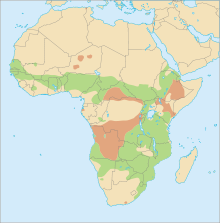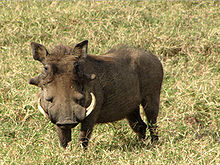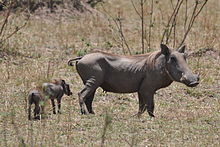- Warthog
-
For other uses, see Warthog (disambiguation).
Warthog 
At Tarangire National Park, Tanzania Conservation status Scientific classification Kingdom: Animalia Phylum: Chordata Class: Mammalia Order: Artiodactyla Family: Suidae Genus: Phacochoerus Species: P. africanus Binomial name Phacochoerus africanus
(Gmelin, 1788)Subspecies 4 sspp., see text
 Distribution of the Common WarthogPossible range or accidental records
Distribution of the Common WarthogPossible range or accidental recordsThe Warthog or Common Warthog (Phacochoerus africanus) is a wild member of the pig family that lives in grassland, savanna, and woodland in Sub-Saharan Africa.[1][2] In the past it was commonly treated as a subspecies of P. aethiopicus, but today that scientific name is restricted to the Desert Warthog of northern Kenya, Somalia, and eastern Ethiopia.[3]
The common name comes from the four large wart-like protrusions found on the head of the warthog, which serve the purpose of defence when males fight as well as a fat reserve.
Contents
Subspecies
- Nolan Warthog (Phacochoerus africanus africanus) (Gmelin, 1788) – Burkina Faso, Ivory Coast, Democratic Republic of the Congo, Ethiopia, Ghana, Guinea-Bissau, Chad, Mauritania, Nigeria, Senegal, Sudan
- Eritrean Warthog (Phacochoerus africanus aeliani) Cretzschmar, 1828 – Eritrea, Ethiopia, Djibouti, Somalia
- Central African Warthog (Phacochoerus africanus massaicus) Lönnberg, 1908 – Kenya, Tanzania
- Southern Warthog (Phacochoerus africanus sundevallii) Lönnberg, 1908 – Botswana, Namibia, South Africa, Zimbabwe
Description
 P. a. massaicus, male, Serengeti, Tanzania
P. a. massaicus, male, Serengeti, Tanzania
Warthogs range in size from 0.91 to 1.5 m (3.0 to 4.9 ft) in length and 50 to 75 kg (110 to 170 lb) in weight. A warthog is identifiable by the two pairs of tusks protruding from the mouth and curving upwards. The lower pair, which is far shorter than the upper pair, becomes razor sharp by rubbing against the upper pair every time the mouth is opened and closed. The upper canine teeth can grow to 23 cm (9.1 in), and are of a squashed circle shape in cross section, almost rectangular, being about 4.5 cm (1.8 in) deep and 2.5 cm (0.98 in) wide. The tusk will curve 90 degrees or more from the root,[citation needed] and the tusk will not lie flat on a table, as it curves somewhat backwards as it grows. The tusks are used for digging, for combat with other hogs, and in defence against predators—the lower set can inflict severe wounds.
Warthog ivory is taken from the constantly growing canine teeth. The tusks, more often the upper set, are worked much in the way of elephant tusks with all designs scaled down. Tusks are carved predominantly for the tourist trade in East and Southern Africa.[citation needed]
The head of the warthog is large with a mane that goes down the spine to the middle of the back.[4] There is sparse hair covering the body. Color is usually black or brown. Tails are long and end with a tuft of hair. Common warthogs do not have subcutaneous fat and the coat is sparse, making them suceptible to extreme environmental temperatures.[4]
The male is called a boar, the female a sow, and the young piglets.
Ecology
 In Ngorongoro Crater, Tanzania
In Ngorongoro Crater, Tanzania Feeding on its knees
Feeding on its knees
The warthog is the only pig species that has adapted to grazing and savanna habitats.[5] Its diet is omnivorous, composed of grasses, roots, berries and other fruits, bark, fungi, eggs and carrion.[6] The diet is seasonably variable, depending on availability of different food items. During the wet seasons warthogs graze[5] on short perennial grasses.[7] During the dry seasons they subsist on bulbs, rhizomes and nutritious roots.[5][7] Warthogs are powerful diggers, using both snout and feet. Whilst feeding, they often bend the front feet backwards and move around on the wrists.[8] Calloused pads that protect the wrists during such movement, form quite early in the development of the fetus. Although they can dig their own burrows, they commonly occupy abandoned burrows of aardvarks[7] or other animals. The warthog commonly reverses into burrows, with the head always facing the opening and ready to burst out if necessary. Warthogs will wallow in mud to cope with high temperatures and huddle together to cope with low temperatures.[9]
Although capable of fighting, with males aggressively fighting each other during mating season, a primary defence is to flee by means of fast sprinting. The main warthog predators are humans, lions, leopards, crocodiles, and hyenas. Cheetahs are also capable of catching small warthogs. However, if a female warthog has any piglets to defend she will defend them very aggressively. Warthogs can inflict severe wounds on lions, sometimes ending with the lions bleeding to death. Warthogs have been observed allowing banded mongooses to groom them to remove ticks.[10]
Social behavior and reproduction
Warthogs are not territorial but instead occupy a home range.[11] Warthogs live in groups called sounders. Females live in sounders with their young and with other females.[6] Females tend to stay in their natal groups while males leave but stay within the home range.[6] Sub-adult males associate in bachelor groups but leave alone when they become adults.[5] Adult males only join sounders that have estrous females. Warthogs have two facial glands; the tusk gland and the sebaceous gland. Warthogs of both sexes begin mark around six to seven months old.[12] Males tend to mark more than females.[12] Places that they mark include sleeping and feeding areas and waterholes.[12] Warthogs use tusk marking for courtship and agonistic behaviors and to establish status.[12]
Warthogs are seasonal breeders.[5] Rutting begins in the late rains or early dry season and birthing begins near the start of the following rain season.[5] The mating system is described as "overlap promiscuity". It is due to the males having ranges overlapping several females and the daily behavior of the female being unpredictable. Boars employ two mating strategies during the rut. With the "staying tactic", a boar will stay and defend certain females or a resource valuable to them.[13] In the "roaming tactic" boars seek out estrous sows and compete for them.[13] Boars will wait for sows to emerge outside their burrows.[5] A dominant boar will displace any other boar that also try to court his female. When a sow leaves her den, the boar will try to demonstrate his dominance and then follow her before copulation.[5] For the "staying tactic", monogamy, female-defense polygyny, or resource-defense polygyny is promoted while the "roaming tactic" promotes scramble-competition polygyny.[13]
The typical gestation period is 5 or 6 months. When they are about to give birth, sows temporarily leave their families to farrow in a separate hole.[5] The litter is 2 to 8 piglets, although 2 to 4 is more typical.[citation needed] The sow will stay in the hole for several weeks nursing her piglets.[5] Warthogs have been observed to engage in allosucking.[14] Sow will nurse foster piglets if they lose their own litter, making them cooperative breeders. Allosucking does not seem to be case of mistaken identity or milk theft.[14] This may be a sign of kin altruism. Piglets are grazing at about 2–3 weeks and are weaned by six months.[5] Warthogs are considered a "follower" species as the young are kept nearby at all times and do not hide.[15]
Conservation status
The warthog population in southern Africa is estimated to be about 250,000.[16] Typical densities range between 1 and 10 per km² in protected areas, but local densities of 77 per km² were found on short grass in Nakuru National Park.[17] There are no current major threats. However, the species is very susceptible to drought and hunting, which may result in localized extinctions in South Africa.[1] The Common Warthog is present in numerous protected areas across its extensive range.[1]
Related species
- Giant Warthog
- Wild Boar
References
- ^ a b c d Cumming, D.H.M. (2008). Phacochoerus africanus. In: IUCN 2008. IUCN Red List of Threatened Species. Downloaded on 5 April 2009. Database entry includes a brief justification of why this species is of least concern.
- ^ Wilson, Don E.; Reeder, DeeAnn M., eds (2005). Mammal Species of the World (3rd ed.). Baltimore: Johns Hopkins University Press, 2 vols. (2142 pp.). ISBN 978-0-8018-8221-0. OCLC 62265494. http://www.bucknell.edu/msw3/browse.asp?id=14200022.
- ^ Wilson, Don E.; Reeder, DeeAnn M., eds (2005). Mammal Species of the World (3rd ed.). Baltimore: Johns Hopkins University Press, 2 vols. (2142 pp.). ISBN 978-0-8018-8221-0. OCLC 62265494. http://www.bucknell.edu/msw3/browse.asp?id=14200019.
- ^ a b Phacochoerus africanus common warthog Animal Diversity Web
- ^ a b c d e f g h i j k Estes, R. (1991). The Behavior Guide to African Mammals, Including Hoofed Mammals, Carnivores, Primates. Los Angeles, University of California Press. pgs. 218–221.
- ^ a b c Kleiman, D.G., Geist, V., McDade, M.C. (2004). Grzimek's Animal Life Encyclopedia, The Gale Group Inc.
- ^ a b c Kingdon, J. (1979). East African Mammals: An Atlas of Evolution in Africa, Volume 3, Part B: Large Mammals. Chicago, University of Chicago Press. pgs. 231–249.
- ^ Unwin, Mike (2003). Southern African wildlife: a visitor's guide. Bradt Travel Guides. pp. 68. ISBN 9781841620602.
- ^ Vercammen, P., Mason, D.R. "Pigs, Peccaries and Hippos Status Survey and Action Plan".
- ^ Warthog - Africa's Jester
- ^ Maher, C. R., Lott, D.F. (1995). "Definitions of territoriality used in the study of variation in vertebrate spacing systems." Animal Behavior 49(1): 581-597.
- ^ a b c d Estes, R.D., Cumming, D., Hearn, G. (1982). "New Facial Gland in Domestic Pig and Warthog." Journal of Mammalogy 63(4): 618-624.
- ^ a b c Sandell, M., Liberg, O.(1992). "Roamers and Stayers: A Model on Male Mating Tactics and Mating Systems." The American Naturalist 139(1): 177-189.
- ^ a b Jensen, S.P., Siefert, L., Okori, J.J.L., Clutlon-Brock, T.H. (1999). "Age Related Participation in Allosucking by Nursing Warthogs." Journal of Zoology London 248(4): 443-449
- ^ Walther, F. R. (1984). Communication and Expression in Hoofed Mammals. Bloomington, Indiana University Press.
- ^ Cumming, D. H. M. 1999. Study on the development of Transboundary Natural Resource Management Areas in Southern Africa - Environmental Context. Natural Resources, Land Use, and Conservation. Biodiversity Support Program. Washington, DC, USA.
- ^ Radke, R. 1991. "Monographie des warzenschweines (Phacochoerus aethiopicus)". Bongo, Berlin 18: 119-134.
External links
- (Common) Warthog at Animal Diversity Web
Categories:- IUCN Red List least concern species
- Mammals of Angola
- Mammals of Burkina Faso
- Mammals of the Democratic Republic of the Congo
- Fauna of East Africa
- Mammals of Ethiopia
- Mammals of Kenya
- Mammals of Namibia
- Mammals of the Republic of the Congo
- Mammals of South Africa
- Mammals of Sudan
- Mammals of Tanzania
- Mammals of Zambia
- Fauna of West Africa
- Mammals of Africa
- Phacochoerus
- Megafauna of Africa
Wikimedia Foundation. 2010.



